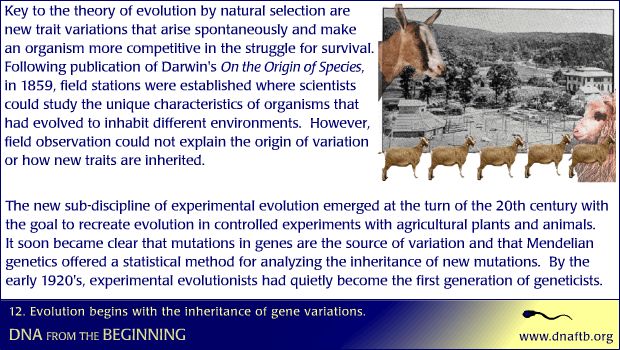Evolution begins with the inheritance of gene variations.

Changes in genes over time lead to evolution.
Key to the theory of evolution by natural selection are new trait variations that arise spontaneously and make an organism more competitive in the struggle for survival. Following publication of Darwin's On the Origin of Species, in 1859, field stations were established where scientists could study the unique characteristics of organisms that had evolved to inhabit different environments. However, field observation could not explain the origin of variation or how new traits are inherited. The new sub-discipline of experimental evolution emerged at the turn of the 20th century with the goal to recreate evolution in controlled experiments with agricultural plants and animals. It soon became clear that mutations in genes are the source of variation and that Mendelian genetics offered a statistical method for analyzing the inheritance of new mutations. By the early 1920's, experimental evolutionists had quietly become the first generation of geneticists.
mendelian genetics, theory of evolution by natural selection, experimental evolution, agricultural plants, genetic variation, field observation, evolutionists, mutations in genes, inheritance, On the Origin of Species, Darwin,
- ID: 16300
- Source: DNALC.DNAFTB
Related Content
16311. Biography 12: Charles Robert Darwin (1809-1892)
Charles Darwin changed the world with his theory of evolution.
11735. "Mathematical Darwinism, A Discussion of the Genetical Theory of Natural Selection," by J.B.S. Haldane, Eugenics Review (vol 23:1)
"Mathematical Darwinism, A Discussion of the Genetical Theory of Natural Selection," by J.B.S. Haldane, Eugenics Review (vol 23:1)
16301. Evolution begins with the inheritance of gene variations.
Animation 12 George Shull used corn to study gene variation.
12032. Charles Davenport letter to Karl Pearson, defending roles of mutation and environment in evolution in paper rejected by Biometrika (6/5/1903) (4)
Charles Davenport letter to Karl Pearson, defending roles of mutation and environment in evolution in paper rejected by Biometrika (6/5/1903) (4)
10396. Program of the 8th annual meeting of the American Breeders Association
Program of the 8th annual meeting of the American Breeders Association
10397. Program of the 8th annual meeting of the American Breeders Association (1)
Program of the 8th annual meeting of the American Breeders Association (1)
12030. Charles Davenport letter to Karl Pearson, defending roles of mutation and environment in evolution in paper rejected by Biometrika (6/5/1903) (2)
Charles Davenport letter to Karl Pearson, defending roles of mutation and environment in evolution in paper rejected by Biometrika (6/5/1903) (2)
16312. Biography 12: George Harrison Shull (1874-1954)
George Shull worked at the Station of Experimental Evolution. He used genetics to improve agricultural yields in corn and other crops.
16206. Biography 5: William Bateson (1861-1926)
William Bateson brought Mendel's laws to the attention of English scientists. Bateson and Reginald Punnett co-discovered "coupling," or gene linkage.
16222. Biography 6: Hugo de Vries (1848-1935)
Hugo de Vries, Carl Correns and Erich von Tschermak-Seysenegg were the three scientists who rediscovered Mendel's laws in 1900.












